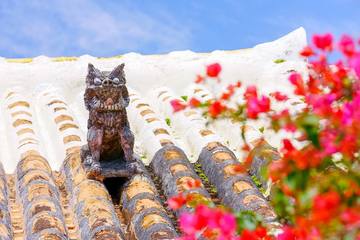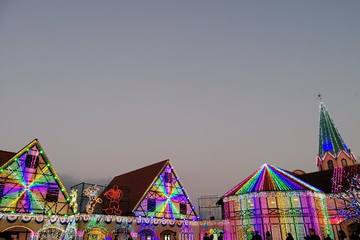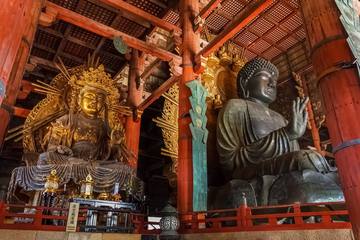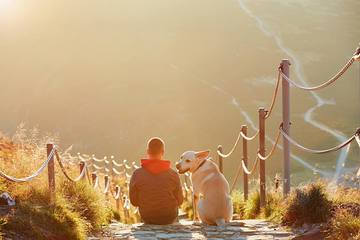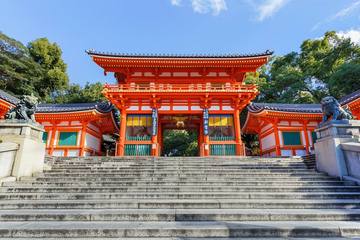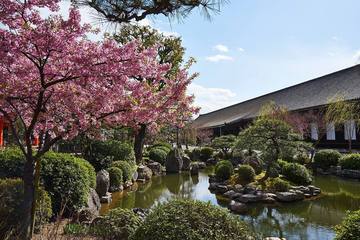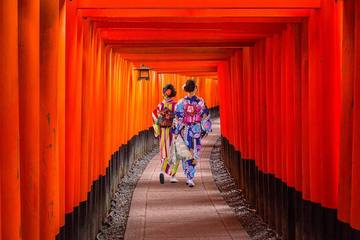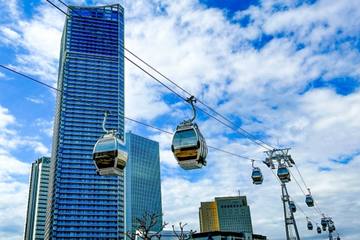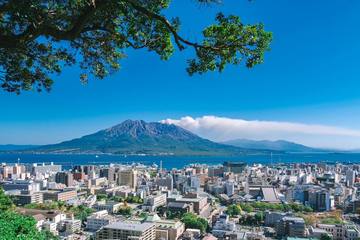
【Kyoto】Kennin-ji Temple|A Summary of the History and Essential Information
Kennin-ji Temple, designated as the third highest-ranking temple among the Kyoto Gozan, is a prestigious temple known as the oldest Zen temple in Kyoto. It boasts numerous important cultural properties and exquisite Japanese art, such as the "Wind and Thunder Gods" folding screen. Due to its strong cultural significance, it is also referred to as a center of learning and is associated with the literary style known as Gozan Bungaku. In this comprehensive guide, we will provide you with the essential historical and basic information you need to know before visiting the captivating Kennin-ji Temple. We will also offer detailed recommendations for local gourmet options in the surrounding area.
*This article is translated using ChatGPT.
For the latest information on each tourist spot and facility, we recommend checking the official website.
- 日本 、京都府
INDEX
Basic Information about Kennin-ji Temple
Admission Fee and Opening Hours
Attractions of Kennin-ji Temple
The "Wind and Thunder Gods" Folding Screen
Yotsugashira Chakai (Four Heads Tea Ceremony)
Recommended Tourist Spots around Kennin-ji Temple
Recommended Local Cuisine around Kennin-ji Temple
Tofu Cuisine Tosuiro Gion Branch
Enjoy Gion to the Fullest with Local Optional Tours!
Basic Information about Kennin-ji Temple
History of Kennin-ji Temple
Kennin-ji Temple, the head temple of the Rinzai sect's Kennin-ji branch, was established in 1202 (2nd year of the Kennin era) by the founder, Zen Master Myōan Eisai (also known as Yōsai), who is credited with introducing the Rinzai sect to Japan. Derived from the name of the era at the time, the temple adopted "Kennin" as its name and "Tōzan" as its mountain name, referring to the Higashiyama area. It is said that the temple's structures were modeled after Mount Baijiang in Song Dynasty China. It served as a prominent Rinzai Zen Buddhist center in Kyoto.
However, the temple faced significant challenges in its early years. It suffered from fires in 1246 (4th year of Kangen) and 1247 (5th year of Kangen), as well as in 1256 (8th year of Kenchō), leading to the destruction and abandonment of its premises. In 1258 (1st year of Shōka), Zen Master Enni (also known as Shōichi Kokushi), the founder of Tōfuku-ji Temple, contributed to the restoration of the Buddha halls and other structures. The following year, in 1259 (1st year of Shōgen), Zen Master Rankei Dōryū, who had come from Song Dynasty China, joined the temple. Initially, Kennin-ji Temple incorporated teachings from the Tendai sect, Esoteric Buddhism (Shingon sect), and Zen, but it later transformed into an authentic Zen training hall focused on Zen practices.
From 1573 to 1592, Ankokuzi Ekei, a diplomatic monk from the Mōri clan, engaged in negotiations with Toyotomi Hideyoshi as an envoy. In 1599 (4th year of Keichō), he relocated the abbot's quarters and Buddha halls, reviving Kennin-ji Temple, which had declined during the tumultuous times of the Ōnin War and other conflicts. Subsequently, with the support of the Tokugawa shogunate, the temple flourished as a center for learning and produced numerous Zen monks renowned for their poetry and artistic talents. It is said that Ikkyū Sōjun, belovedly known as Ikkyū-san, also studied poetry at Kennin-ji Temple.
Following the implementation of anti-Buddhist policies during the Meiji era, the temple's grounds were reduced in size, resulting in its current form.
Access
Address: Komatsu-cho, Shimogyo-ku, Kyoto City, Kyoto Prefecture, Japan
The nearest stations to Kennin-ji Temple are Gion-Shijo Station on the Keihan Electric Railway and Kawaramachi Station on the Hankyu Railway. It's about a 7-minute walk from Gion-Shijo Station and approximately a 10-minute walk from Kawaramachi Station.
For those coming from JR Kyoto Station, using the city bus is convenient. Take bus route 206 from the "Kyoto Station" bus stop and get off at the "Higashiyama Yasui" bus stop. Alternatively, you can take bus route 100 and get off at the "Gion" or "Kiyomizu-michi" bus stop. From the "Higashiyama Yasui" bus stop, it's about a 5-minute walk, and from "Gion" or "Kiyomizu-michi," it's approximately a 10-minute walk to the temple.
Admission Fee and Opening Hours
The admission fees are as follows: 600 yen for adults, 300 yen for middle and high school students, and 200 yen for elementary school students. Children under elementary school age can enter for free.
The temple is open from 10:00 AM to 5:00 PM. The visit usually takes about 30 to 40 minutes, but the duration may vary depending on how you explore. Please note that the reception closes 30 minutes before closing time at 4:30 PM, so it is recommended to visit with ample time.
Attractions of Kennin-ji Temple
The "Wind and Thunder Gods" Folding Screen
The "Wind and Thunder Gods" folding screen is a large pair of screens featuring unique and striking depictions of the Wind God and the Thunder God. It is famous for its impactful use of shining gold leaf. The replica displayed in the Daisodo (Great Lecture Hall) is a highly detailed reproduction, while the original is preserved at the Kyoto National Museum.
The artist behind this masterpiece is Tawaraya Sōtatsu, a prominent painter of the Edo period and considered the founder of the Rinpa school. The bold arrangement of the Wind God and the Thunder God effectively guides the viewer's gaze, creating an immersive artistic experience. The background, adorned with layers of gold leaf, represents the "infinite space," while the clouds painted on top utilize a technique called "tarashikomi," where colors are intentionally blended by applying wet paint on top of another color to depict the texture of the clouds. This technique is said to be the first instance of its use in Japanese painting, pioneered by Sōtatsu.
Designated as a National Treasure, this artwork is considered one of his greatest masterpieces. Within the temple grounds, you can also find temple seal books (Goshuincho) featuring the "Wind and Thunder Gods" design available for purchase, which adds to its enduring popularity among visitors.
Hatto (Dharma Hall)
The Hatto, also known as the Nenge-do, is the Dharma Hall of Kennin-ji Temple. It is a Zen-style Buddhist hall that also serves as the main hall of the temple. The Hatto was constructed in 1765 (2nd year of the Meiwa era). It houses the main statue of Shakyamuni Buddha seated, accompanied by the attendant figures of Kasyapa and Ananda.
The ceiling of the Hatto features a painting called the "Twin Dragon" by the Japanese painter Jun Sō. This ceiling painting was created over a period of approximately two years and completed in 2002 to commemorate the 800th anniversary of Kennin-ji Temple's founding. The painting depicts two intertwined dragons, known as "A-un," and covers an area equivalent to 108 tatami mats, creating a breathtaking and powerful visual spectacle. The temple seal book (Goshuincho) adorned with the "Twin Dragon" design is also popular among visitors.
Hojō (Abbot's Quarters)
The Hojō, or Abbot's Quarters, of Kennin-ji Temple is a Zen-style architectural structure that was relocated from Ango-ji Temple. It has been designated as an Important Cultural Property. The main object of worship in the Hojō is the Eleven-faced Kannon Bodhisattva statue donated by the Tokufukumon'in.
The interior of the Hojō once featured a series of 50 ink paintings on sliding doors known as the "Kennin-ji Hojō Shōhekiga" (Ink Paintings on the Sliding Doors of the Abbot's Quarters). The paintings were created by Kaihō Yūshō, and they are said to date back to the Azuchi-Momoyama period. The series consists of 16 panels depicting the "Seven Sages of the Bamboo Grove," 10 panels illustrating "Music, Chess, Calligraphy, and Painting," 8 panels portraying "Dragons in the Clouds," 8 panels displaying "Landscape Paintings," and 8 panels featuring "Flowers and Birds." All of these paintings have been designated as Important Cultural Properties.
Among them, the "Dragons in the Clouds" sliding door series consisting of 8 panels is displayed in the "Rei no Ma" (Room of Courtesy), the first room where guests were received in the Hojō. These panels depict powerful dragons emerging from the clouds. Dragons were a favorite subject of Yūshō, and this particular work, spread across the expansive canvas of 8 panels, is considered a remarkable masterpiece. The current sliding door paintings displayed in Kennin-ji Temple are highly detailed reproductions created to commemorate the temple's 800th anniversary. The original panels are preserved at the Kyoto National Museum.
Gardens
Kennin-ji Temple is also known for its exceptional dry landscape gardens that can be enjoyed within the temple grounds. Let me introduce you to a few of them.
First, we have the "Daio-en" garden. This garden is located in front of the Hojō and is centered around the gate of the Hatto. It is a dry landscape garden created by the renowned Showa period gardener Kato Kumakichi during the reconstruction of the Hojō. The garden features stone pagodas and red pine trees, which were erected by Oda Uraku-sai, the brother of Oda Nobunaga, as a memorial to Nobunaga. They are carefully placed on top of the white sand patterns representing Shirakawa sand.
The second garden is the "Chōon-tei" garden, which was opened to the public in 2005 as the courtyard of the Honbō. This garden is a modern dry landscape garden that faces all four directions. It is highly praised for its beautiful moss and autumn foliage. Since it can be viewed from various points within the Honbō, I recommend exploring it from different angles to appreciate its diverse expressions.
Lastly, we have the "Maru-San-Kaku no Niwa" garden, also located in the Honbō. This garden represents the four elements of Zen Buddhism, "Earth, Water, Fire, and Wind," in the form of a garden. The well symbolizes "Earth" with its square shape (□), the moss represents "Water" with its circular shape (◯), and the white sand represents "Fire" with its triangular shape (△).
These gardens offer a serene and contemplative atmosphere, allowing visitors to immerse themselves in the beauty of nature while experiencing the essence of Zen.
Enjoying Kennin-ji Temple
Zazen Meditation Experience
At Kennin-ji Temple, the "Senkōkai" meditation session is held on the second Sunday of every month. It is a chance to experience zazen meditation. The best part is that it's free to participate, and no reservations are required, making it accessible even for beginners. After the meditation, you can join in the chanting of sutras and listen to a Dharma talk given by a Buddhist monk. The session usually lasts for about two hours, starting at 7:30 AM. If you have the opportunity to visit this prestigious Zen temple in the early morning, I highly recommend trying out zazen meditation.
Yotsugashira Chakai (Four Heads Tea Ceremony)
The Yotsugashira Chakai, also known as the Yotsugashira Charei, is a traditional tea ceremony that is said to have been brought to Japan by Zen Master Eisai from China during the Kamakura period. It is considered the precursor to the current tea ceremony. This tea ceremony, held as a noble reception, serves tea using high-quality porcelain tea bowls called Tenmoku chawan, along with exquisite red and white sweets. The Yotsugashira Chakai has been recognized as an Intangible Folk Cultural Property by the city of Kyoto, and with a reservation, anyone can participate, regardless of background.
In addition to these experiences, Kennin-ji Temple has other tea-related attractions, such as the Hokuon Tearoom, where Toyotomi Hideyoshi held the Hokono Daisan Chakai, and the Toyo Bō Tearoom, favored by Sen no Rikyū's disciples. This temple is deeply connected to the art of tea ceremony.
Recommended Tourist Spots around Kennin-ji Temple

Ryōsoku-in Temple
Ryōsoku-in is a sub-temple of Kennin-ji Temple and is famous for its "Hange-shō" (Half Summer) event. During Hange-shō, the leaves partially turn white in early summer, creating a beautiful and admired appearance. While usually not open to the public, during the peak of Hange-shō, areas such as the Hojō (abbot's quarters), Shoin (drawing room), and gardens are specially opened to visitors. The cute tiger-shaped "Tora Mikuji" (fortune-telling strips) are also popular here.
Address: 591 Komatsu-cho, Shimogyo-ku, Higashiyama-ku, Kyoto City
Hanamikoji Street
Hanamikoji Street, centered around Shijo Street, is considered the main street of the Gion district, extending from Sanjo Street to Kennin-ji Temple. It features charming buildings with red lattice windows and dog-legged fences, exuding the atmosphere of historic Kyoto. Particularly around Kennin-ji Temple, the street is paved with stone tiles, providing a taste of the traditional Gion ambiance.
Address: Gion-machi Minami-gawa, Higashiyama-ku, Kyoto City, Kyoto Prefecture
Yasui Konpira-gū Shrine
Yasui Konpira-gū Shrine is known for its reputation in matchmaking and breaking of ties. Its origins date back to the years 668-671 when Fujiwara no Kamatari established the shrine. The shrine is famous for its unique method of matchmaking, where visitors write their wishes on substitute paper talismans, pass through the "Enmusubi Enmusubi Hi" (Ties and Unraveling of Ties Monument), and affix the talismans onto the monument.
Address: 70 Shimobentei-cho, Higashiyama-ku, Kyoto City, Kyoto Prefecture
Yasaka Shrine
Yasaka Shrine, also known as Gion Shrine, is a well-known shrine with its famous Nishi-ro-mon Gate. With a deep historical significance believed to predate the Heian period, the shrine is associated with the important deity "Susanoo-no-Mikoto" from Japanese mythology. It is believed to bring blessings for warding off illness and ensuring good health. Yasaka Shrine is considered the head shrine of all the shrines dedicated to "Susanoo-no-Mikoto."
Address: 625 Gion-machi Kitagawa, Higashiyama-ku, Kyoto City, Kyoto Prefecture
Recommended Local Cuisine around Kennin-ji Temple
Gion Kirara
Gion Kirara is a Kyoto-style restaurant where you can enjoy a variety of obanzai (traditional Kyoto home-style dishes) such as sashimi, grilled dishes, and tempura, all made with seasonal fresh fish. Their lunch "Saigohan" set is priced at 2,000 yen, and the "Kirara Gohan" set is priced at 3,000 yen, offering generous portions at relatively affordable prices. It's a great place to casually experience the refined dining of Gion.
Address: 570-232 Gion-machi Minami-gawa, Higashiyama-ku, Kyoto City, Kyoto Prefecture
Yatsudaime Gihei
Yatsudaime Gihei is a "rice restaurant" specializing in delicious Japanese cuisine centered around rice. They serve freshly cooked rice in their original earthen pots. For lunch, they offer set menus with dishes like sashimi and oyakodon (chicken and egg rice bowl), allowing you to enjoy the flavors of white rice. For dinner, they have course menus that fully showcase rice, incorporating rice wine and sauces made from rice, as well as sushi.
Address: 296 Gion-machi Kitagawa, Higashiyama-ku, Kyoto City, Kyoto Prefecture
Tofu Cuisine Tosuiro Gion Branch
Mamezuro is a traditional Japanese restaurant where you can enjoy kaiseki cuisine with a focus on tofu dishes. In addition to yudofu (tofu hot pot) and tōfu dengaku (grilled tofu with miso), they offer authentic Kyoto cuisine using seasonal ingredients. The interior of the restaurant, renovated from a 150-year-old machiya (traditional Kyoto townhouse), maintains the charming atmosphere of Gion. They also offer vegetarian-friendly course options, catering to diverse dietary preferences.
Address: 38-1 Bishamon-cho, 4-chome, Higashiyama-ku, Kyoto City, Kyoto Prefecture, along Higashioji Street, Matsubara-agaru
Enjoy Gion to the Fullest with Local Optional Tours!
Around Kennin-ji Temple, there are many charming spots such as Gion, Yasaka Shrine, and Kiyomizu-dera Temple. Each spot has a rich history, and it can be challenging to navigate if you're unfamiliar with the area. For those in such a situation, I recommend taking a sightseeing tour on a rickshaw. The rickshaw pullers, who are well-versed in local information, will guide you through the history, tasty recommendations, and the best sightseeing routes, making your Kyoto experience even more enjoyable. Whether it's your first time in Kyoto or you've been here before, riding a rickshaw and listening to the guide's insights will allow you to appreciate the city from a higher perspective. In addition, VELTRA offers various local optional tours that make your trip even more enjoyable, such as maiko (apprentice geisha) experiences and kimono rentals at tea houses in Gion. Be sure to check them out!
*Transportation fares, facility fees, operating hours, etc., are subject to change without notice. Please also check the official website for the latest information.
*Thank you for reading the article!
To improve YOKKA's service, we kindly request your participation in a survey below.
YOKKA


